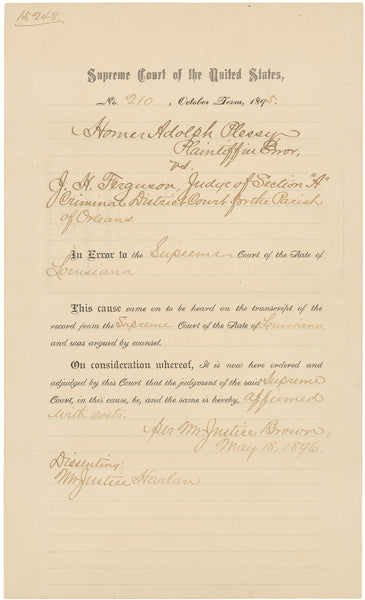Plessy v. Ferguson: An Excerpt from Firsthand LouisianaPosted in Articles, History, Law, Louisiana, Media Archive, United States on 2021-09-15 02:06Z by Steven |
Plessy v. Ferguson: An Excerpt from Firsthand Louisiana
University of Louisiana at Lafayette Press
2020-08-13
Devon Lord, Editor In Chief
Discover the history of the Pelican State through the eyes of the people who lived it and shaped its course. In Firsthand Louisiana: Primary Sources in the History of the State, historians Janet Allured, John Keeling, and Michael Martin have compiled dozens of important, interesting, devastating, and even entertaining firsthand accounts cover Louisiana’s history along with questions for further analysis and discussion. Below is an excerpt concerning the Plessy v. Ferguson Supreme Court decision and its impact on Louisiana and the nation as a whole.
1896:PLESSY V. FERGUSON
The most important United States Supreme Court case to originate in Louisiana is Plessy v. Ferguson, which in 1896 affirmed the constitutionality of southern segregation laws. In 1890 the Louisiana legislature passed the state’s first segregation bill, the Separate Car Act, which required that railroads provide separate cars for white and black passengers. As a state senator from St. John the Baptist Parish, Henry Demas was one of four remaining African American Republicans in that chamber. In response to the act, leading members of the Afro-Creole community in New Orleans formed the Comité des Citoyens (Citizens Committee) to challenge the legality of the act. On June 7, 1892, Homer Plessy bought a first-class train ticket from New Orleans to Covington and boarded the white passenger car. A private detective hired by the committee ensured that the conductor had him arrested for violating the Separate Car Act, and the test case began. After losing both in a local court and the Louisiana Supreme Court, the case was appealed to the US Supreme Court. In a 7–1 decision, the Court upheld the constitutionality of the Separate Car Act, asserting, among other points, that it was a reasonable exercise of the state’s police power to maintain the health, safety, and morals of its citizens. Associate Justice John Marshall Harlan, however, saw through the reasoning behind the law and the majority opinion, and declared in the most famous dissenting opinion in the history of the Court that the decision established second-class citizenship for African Americans in the South. Through the “separate but equal” rule, that accommodations for each race had to be roughly the same in quality, Jim Crow laws came to dominate southern race relations until overturned fifty-eight years later by Brown v. Board of Education…
Read the entire article here.
